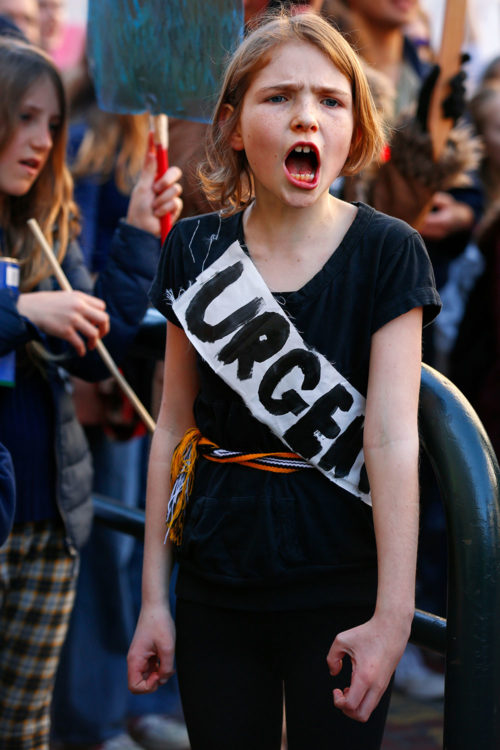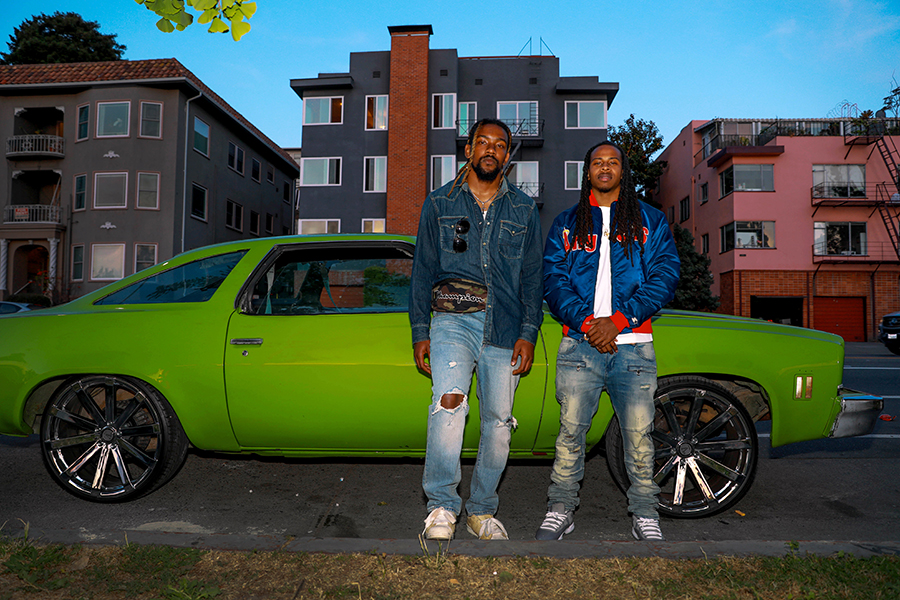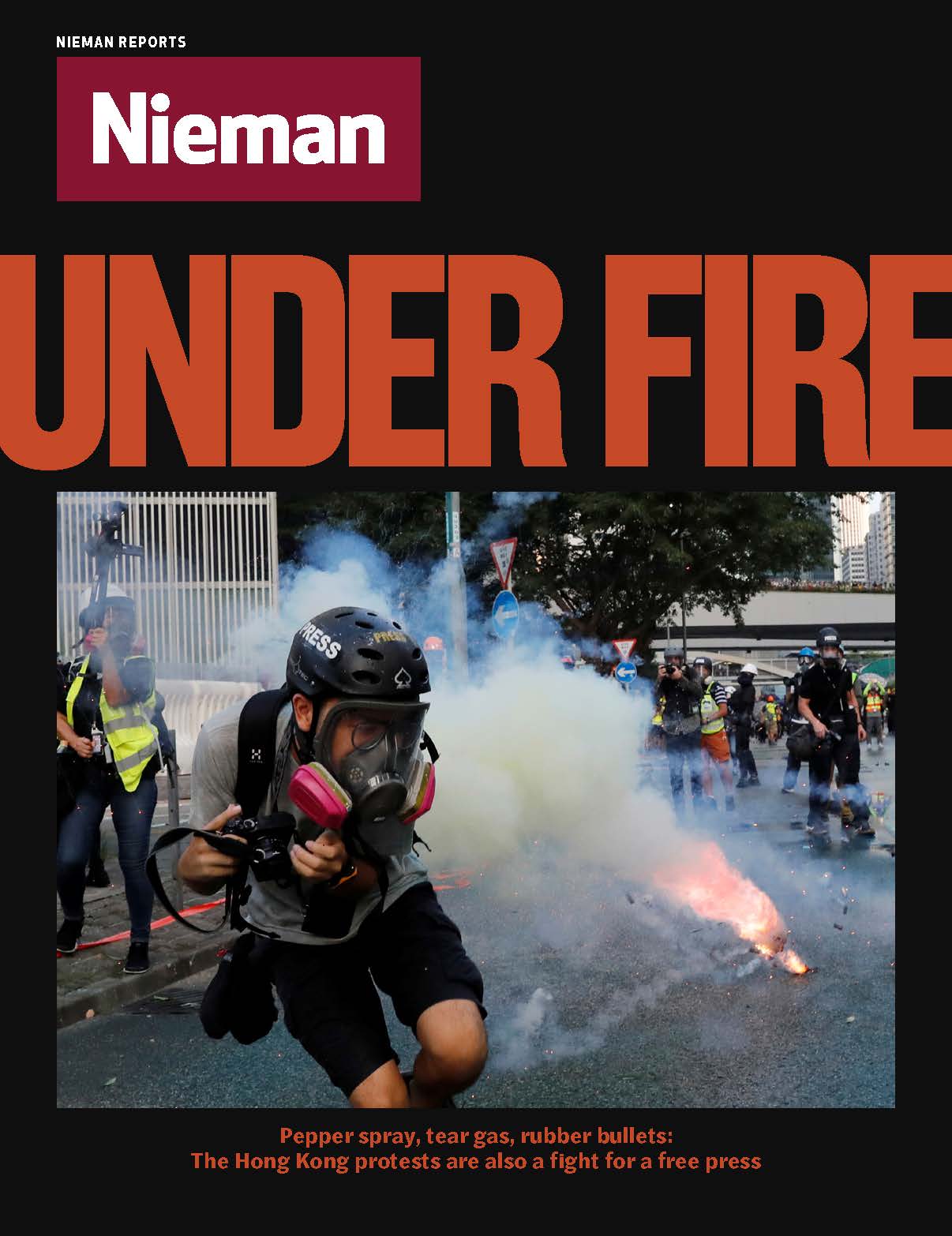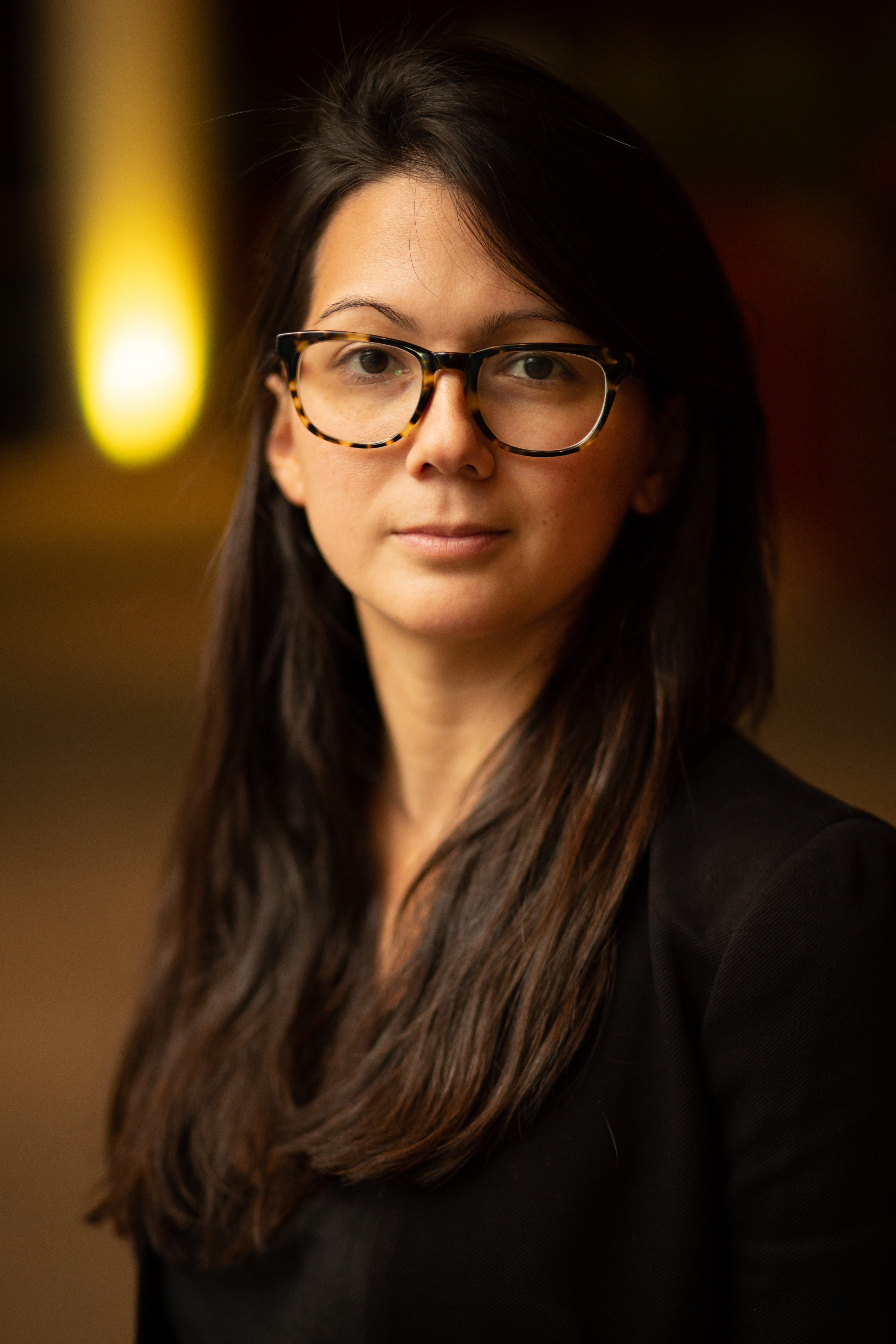
Magdalena Meyers, 10, marches to Sen. Dianne Feinstein’s office in San Francisco during a student walkout protesting inaction on climate change in March 2019. The San Francisco Chronicle features work by female photographers like Amy Osborne on page one at a rate significantly higher than other major news organizations
In 2016, I attended a photography festival in France that serves as one of the primary annual gatherings for photographers and photo editors. I ran into an editor at a major publication who I knew in passing and we stopped, briefly, to catch up. It was France in July, 90 degrees, and we’d both had at least one glass of wine. I asked, in an I’m-only-serious-if-you-take-it-well kind of jovial tone, why her outlet didn’t hire more women photographers.
She blinked, looked at me, and said, “Well, I’d hire more women if I knew where to find them.”
It was neither the first nor the last time I’d hear a photo editor utter those exact words, but it stuns me every time. If?
I went back to my Airbnb that evening and furiously started a Google spreadsheet to aggregate the names of women photojournalists I knew. The next year, that document led to the creation of Women Photograph, a nonprofit now working to elevate the voices of women and nonbinary visual journalists. The database currently includes nearly 1,000 photographers from over 100 countries and serves as a hiring resource for editors and gatekeepers. We have given out about $120,000 in grant funding to support new and ongoing projects. In addition, we run a mentorship program and an annual workshop, and collect data on hiring and publishing habits in the photojournalism industry.
While a lot of work remains to be done, it’s also necessary to celebrate—and emulate—models of progress
Anecdotally, we know that roughly 15 to 20 percent of working photojournalists are women. It’s a hard statistic to pin down: there is no international industry census that gives us a comprehensive overview of what kinds of people are responsible for visualizing the news.
The figure may come from the World Press Photo’s State of the Industry Reports, which from 2015-2018 registered somewhere from 15 to 18 percent women respondents.
Women Photograph’s own data reinforces that figure. I rely on a handful of metrics to quantify how the news photography industry is doing in terms of gender representation behind the lens. Every Monday, I sort through some of the “Photos of the Week” slideshows that nine big outlets publish more or less as highbrow clickbait. They’re meant to showcase major news events, some lighthearted moments, and show off their journalists’ work from the past seven days.
I’ve been doing this for two years now, aggregating the results every week on Twitter for public consumption. In 2018, I recorded the credits for 8,665 images from Al Jazeera, The Atlantic, the BBC, Bloomberg News, BuzzFeed News, CNN, The Guardian, Reuters, and The Washington Post. A total of 1,512 or 17.4 percent of those images were credited to women photographers.
And for the past three years, the Women Photograph data team has also looked at the credit for the lead photo on the front pages of eight North American and European newspapers every morning: The New York Times, The Washington Post, The Wall Street Journal, the Los Angeles Times, the San Francisco Chronicle, The Guardian, The Globe & Mail, and Le Monde. In 2017, 13.4 percent of those photos were credited to women. In 2018, it rose slightly to 17.5 percent.
There’s a long list of reasons why the small number of women photojournalists is a problem. The most obvious is that it’s a hiring equality issue: when we know that a majority of students in undergraduate and graduate photojournalism programs are women, there is something broken in a system that chases nearly all of those would-be photographers out of the industry. But more important still is the impact that this lack of inclusivity has on the wider public. Photojournalists shape the way we see our world: they introduce us to people and places we might never otherwise understand by allowing us to see what they see. And while the longtime trope of the documentary photographer has been one of an unbiased, objective, fly-on-the-wall observer, the truth is that our own identities and lived experiences deeply impact how we tell stories.
Whether it’s because of better access, greater comfort, or simply seeking out the stories of people we identify with, photographers often are more drawn to document people in whom they see themselves. And when only 15 to 20 percent of working news photographers are female, that means more often than not, women will find themselves excluded from the mainstream narrative.
It’s easy to assign blame elsewhere but the truth is, if an organization is committed to change, a cultural shift is easily attainable
None of those statistics I cited above are particularly heartening, but it’s important to note that there are outliers, and change is happening—and while a lot of work remains to be done, it’s also necessary to celebrate—and emulate—models of progress.
I routinely find that there’s a fabricated sense of helplessness in conversations about why these numbers remain so low. It’s easy to assign blame elsewhere: to the wire services, to a pipeline problem, to a lack of mentors. But the truth is, if an organization is committed to change, a cultural shift is easily attainable.
At the end of 2017, The New York Times international picture editor David Furst asked his five international photo editors to reach gender parity in their freelance and staff assignments. By April 2018, “they hit a gender-equal assignment threshold across the whole international report, and haven’t dropped below that standard since,” Furst says.
“It was tough. It was a lot of work. It was a lot of trying to retool the operation to accomplish that, to recognize there had been a deficiency,” he says. “But I wanted to get us to gender equal reporting because it’s a more accurate way of reporting on the world.”
For the San Francisco Chronicle, which almost certainly boasts the most diverse photography staff in the United States (6 out of 10 photographers are women, 7 out of 10 are people of color), the evolution of their A1 lead photo numbers was swift and methodical.

Cousins Kingdom Chambers (left), 27, and Kuda Mills, 27, pose for a portrait in front of Kuda's 1973 Chevelle on Mother's Day 2019 in Oakland, California. The San Francisco Chronicle publishes an unusually high number of photographs by women, in part because six of 10 staff photographers are women
“At a time when local news is suffering so much and we’re not connecting with readers the way we should be, this is a really simple and elegant way to reflect back the community and connect better with the people we’re trying to reach,” says Nicole Frugé, the Chronicle’s director of photography. “In a way it’s a selfish act. How do you build a better team? By building a more diverse team.”
In 2018, quarter by quarter, the percentage of lead photos on the front page of the SF Chronicle made by women photographers came in at 25.6 percent, 37.4 percent, 43.5 percent, and 56.5 percent respectively. By way of comparison, neither The Wall Street Journal, The Guardian, nor Le Monde managed to break 10 percent.
“We had all these women on staff, but the numbers [at the start of 2018] didn’t reflect the diversity of the staff,” says Frugé. “The assignment editor [Alex Washburn] wanted to make that change so that we could show who we are as an organization—I gave her as much support as I could to help her find people so we could broaden out who we hire.” The entire photo desk now regularly turns to resources like the Authority Collective, Diversify Photo, and Women Photograph to source new visual journalists and continue to add new voices to their roster.
But to be fair to The Wall Street Journal, The Guardian, and Le Monde, part of the reason that their numbers are so abysmal is that they are some of the papers relying most heavily on wire services for their imagery. That brings us to Bloomberg News—which as a news agency perhaps doesn’t have quite the same photographic reach as Reuters, the Associated Press, and Getty Images given its focus on finance, but is certainly working the hardest to change its numbers.
In looking at the Photos of the Week slideshows for the first six months of 2019, 8.7 percent of AP’s selected images were credited to women photographers. For Reuters, it was 16 percent. For Bloomberg News? The share is 48.7 percent. There’s a critical difference at Bloomberg News—it only has one staff photographer and mostly relies on freelancers, which makes a complete roster turnover pretty simple. Not so for Reuters or the AP, who employ hundreds of staffers combined around the globe. But it doesn’t mean they can’t try, either in their new staff hires or in the stringers and freelancers they commission on a daily basis.
When asked to comment on their own progress toward parity, Lauren Easton, the AP’s global director of media relations, says, “We do make an effort to hire women photographers as freelancers and stringers when we can, and we are committed to giving women in our photo department opportunities for growth and advancement. … While there has been some improvement, there is more work to do.” Reuters Pictures’ global editor Rickey Rogers shared that while at the start of 2018 only 8-9 percent of assignments at Reuters went to women photographers, the company-wide goal (which it is on target to reach) is to hit 20 percent by the end of 2019. In addition, roughly 25 percent of Reuters’ staff and contract photographers are now women. The AP declined to comment on specific figures regarding their photographers or assignments. When asked to comment, Getty Images (full disclosure: Getty has sponsored a $10,000 Women Photograph grant in 2018 and 2019) also did not respond to requests to share company data on hiring and assigning habits, but it has no full-time news photographers on staff who are women.
“The Photos of the Week was a great platform for us to use to look at our efforts,” says Farah Shulman, head of visual media for the Americas at Bloomberg News. “And if every week was difficult, it meant we weren’t hiring enough women for the job, so it made us make a more conscious effort.”
There is no single solution to the severe imbalance that continues to plague photojournalism
And like at The New York Times, Graham Morrison, Bloomberg’s managing editor of visual media globally, says that change most effectively comes from the top down. “We all have to have this shared goal,” he says, where managers are held accountable and there’s a company-wide conversation about raising the visibility of women both responsible for producing the news and appearing in the news. “It matters to us who assigns, who reports, who edits, who shapes it, and who is quoted in it.”
There is no single solution to the severe imbalance that continues to plague photojournalism. But each of these organizations has found its own path—through hiring, assigning, editing, and curating—to push for change.
It is easy to examine all the ways in which the fight for true gender parity is a Sisyphean task. But mostly, I would love for us to think of the field of photojournalism as an opportunity. We can’t hope to change the makeup of our Congress or Supreme Court overnight, or suddenly reach gender parity in corporate boardrooms or police forces. That kind of sea change will require years of steady work. But to change the way we see? To shift the makeup of the gatekeepers responsible for telling the human story, for introducing our audiences to new people, new places, and new ideas? That, we can do virtually overnight. And we should.
“I don’t think people should talk themselves out of trying to do something because they can’t fix it all,” says Frugé. “The more of us that just try, whether it’s ‘I’m going to take my next intern hire and not just wait for people to apply, but go out and recruit’ or take your freelance pool and have a portfolio day: take one thing that needs addressing the most and go from there and build on it. All of this is step by step, inch by inch, and I think certainly some people have more change they need to make than we did, but that doesn’t mean we shouldn’t all try.”
Alex Washburn’s title was incorrect in an earlier version of this article.



